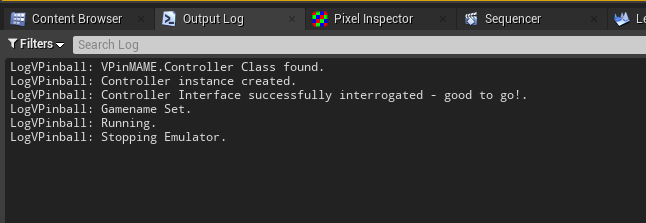Welcome!
- release - tested, should be good to go - this will be the branch to start making playable games with.
- main - main development branch - should be good to pull and work with but may have issues.
- dev-XXX - WIP development branches - more likely to be unstable, buggy, or fuggly.
Enough of the core MAME API's should be up and running to start putting together functional machines. API's are still fluid, so expect to have to update and rebuild blueprints from time to time.
Current tasks: Ongoing refactoring and reorganizing. Fleshing out the remainder of the API. Documentation/Examples.
- Unreal running in Windows - I'm running 4.26 in Windows 10. Earlier versions may work.
- VPinMAME installed and runnable - quickstart: install this and note the location of VPinMAME within that install.
- game ROMs installed in VPinMAME's ROMs folder - We can't help you with this part... for reasons.
- for developers: compiler/dev env - I'm using Visual Studio 2019.
Unreal-Visual-Pinball uses COM object (COM component) communications to interface with VPinMAME's DLL. When VPinMAME is properly installed, it sets up registry keys that tell COM where to find the DLL. If those keys aren't properly set up, the system will not run.
"...those tiki-torches must be kept lit.... those seeds must be kept warm.... if those seeds die.... we die!"
This is kind of standard practice for GitHub Unreal plugins, but it goes kind of like this:
- Create a new Unreal project.
- Create a
Pluginsfolder in your project directory. - Clone the GitHub repository into your
Pluginsfolder. - Right-click on your Unreal project's
.uprojectfile and selectGenerate Visual Studio Project Files - Open your Visual Studio Solution file and compile your Unreal C++ project.
Huge thanks go to Datasung from bits4u.nl. He started the project as an Unreal C++ code project and allowed me to jump in, convert it to an Unreal Plugin, and start implementing some more features and ideas. We're both big pinball fans -- the art, the technology, the comradery -- and of all the work that's been done in the visual/virtual pinball space.
Wanna play along? Help is welcome - you can contact me on my discord server. I'm cptvideo.
We welcome contributions through GitHub Pull Requests and Issues are open for any enhancement suggestions and bugs reports. We try to adhere to Epic's Coding Standards.
Greetings and welcome! First, a quick word of warning: This is an in-development project - it is not ready for play-testing and no playable games have been built with it...😉 yet.
No, not yet. This is really just an early (pre-alpha) development project right now, so don't worry, you're not missing anything :-) As soon as we have something that we can include here, we will.
Blueprints. The idea is that you set up "switch" events (button pushes, ball rollovers, etc.) that are passed to the ROM. The ROM sends back "solenoid" events that you implement to fire off things like flipper movements, kickers, slingshots, etc.
The ROM is the firmware (program) burned into a chip on an IRL pinball machine. It's the brains of 'modern' pinball machines. The ROM manages game modes and progression, scorekeeping, sounds, lights, solenoids, DMD display output, and all the other rando-electro-mechanical-dohickeys that make pinball so wonderful. The idea here is to provide a C++/Blueprint interface to the ROMs so we can build virtual pinball machines in Unreal. In effect, this opens up a world of pinball fun - not only running pinball machines as a game on a computer, but allowing us to design, modify, and build games that could be built as physical machines in the real world; taking input from physical buttons on a cabinet, and sending signals to fire real world things like, lights, flippers, & solenoids attached to pop-bumpers, etc.
Apparently so. I haven't tried it yet, but there is this toolkit for generating ROM images. If anyone is working with this and might be interested in building some simple test-fixture ROMs, please contact me. These would be roms that do things like simply firing solenoid and light events, DMD diagnostics, and processing input switches.
No, not yet :-)
Plugin logging happens under the log category, LogVPinball. You can filter the
Output Log to track plugin info and help with
installation problems.
To utilize this category in your own C++ game or plugin code,
include #include "<path>/E4_VPinMAME.h"
and put DEFINE_LOG_CATEGORY(LogVPinball); at the top of your source file. From
there you can use UE_LOG(LogVPinball, Log, TEXT("Test Log Message")); from within
your own source code. Change "Log" to whatever verbosity level you wish:
(Fatal|Error|Warning|Display|Log|Verbose|VeryVerbose).

